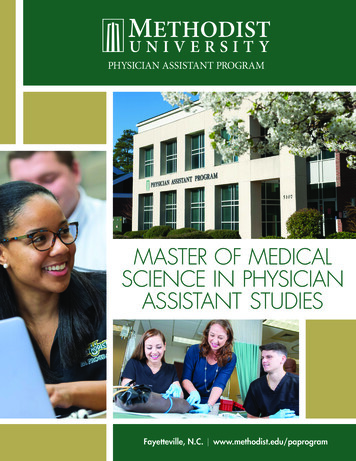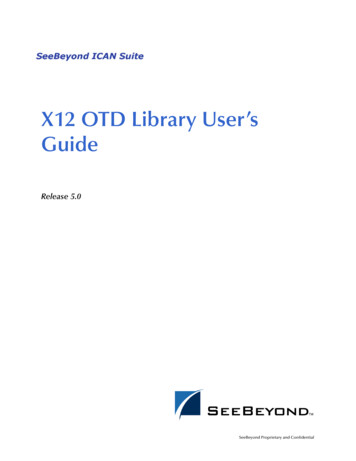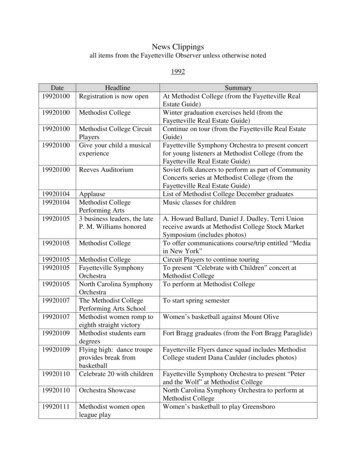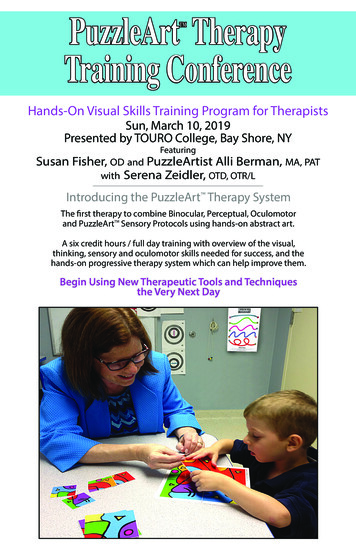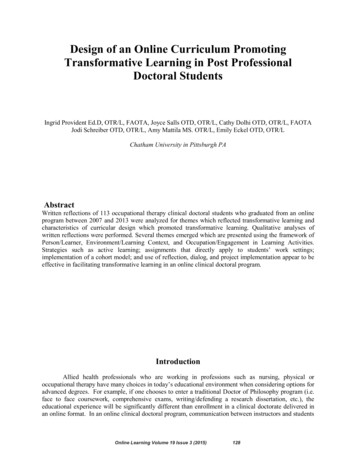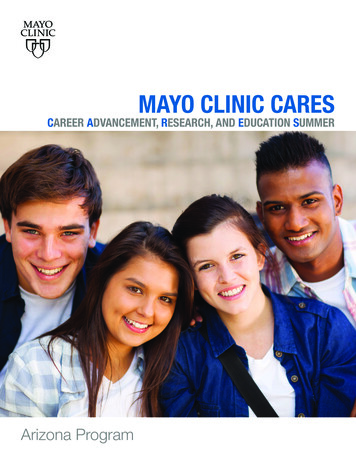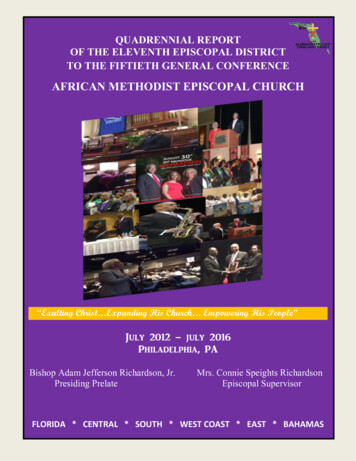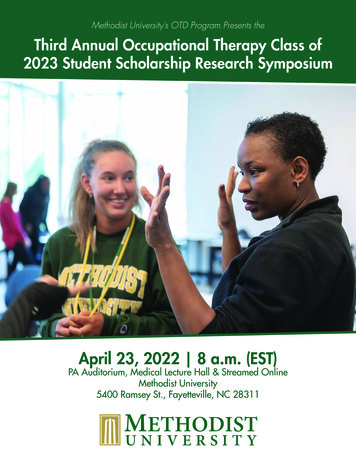
Transcription
Methodist University’s OTD Program Presents theThird Annual Occupational Therapy Class of2023 Student Scholarship Research SymposiumApril 23, 2022 8 a.m. (EST)PA Auditorium, Medical Lecture Hall & Streamed OnlineMethodist University5400 Ramsey St., Fayetteville, NC 28311
TABLE OF CONTENTSTABLE OF CONTENTSIntroduction to the OTD Symposium. 3OTD Scholarly Agenda. 3Faculty Capstone Mentors. 3Agenda . 4Abstracts and Presenters.5-11ZOOM LINK wd RmhxRjd2cHRnbDYvNkQreFNSZ3Q5dz09Meeting ID: 854 6740 1901Pass code: 4153782Third Annual Occupational Therapy Symposium
THIRD ANNUAL OTD SYMPOSIUMIntroduction to the OTD SymposiumThese student presentations represent a component of the OTD curriculum that meets the educational standardsfor scholarship and evidence-based practice. The Clinical and Community Capstone Scholarly Project is part oneof the capstone curriculum and begins in the summer term of the first year of the program.This project is mentored by a faculty member and is aligned with the mentor’s scholarly agenda. Completionof the Capstone Scholarly Project prepares the student and serves as the impetus for the culminating CapstoneExperience. It generally begins with a literature review, PICO question generation, traditional qualitative orquantitative methods of inquiry, and culminatesin the final didactic semester of the program withpeer-reviewed dissemination efforts.OTD Scholarly AgendaOur departmental faculty scholarship agenda seeksto build quality evidence that spans the depth andbreadth of the occupational therapy profession.The OTD program faculty, in collaboration withour students, strives to advance the professionthrough scholarly engagement, enrichment, andempowerment. Collectively, our scholarly work willcreate a well-rounded, creative, and collaborativeenvironment that uses a multidisciplinaryapproach to incorporate the basic and appliedsciences, including rehabilitation science, healthand wellness, social sciences, and engineering.Pragmatically, our research is grounded in theory,molded by the grant-writing process, and executedin clinical and community-engaged settings.Simultaneously, our faculty scholarship agendacoincides with the evidence-based practice andresearch course series, allowing us to build a strongpeer-mentor relationship with our OTD studentsand foster student-led capstone scholarship. Theultimate goals of our work are to create evidencedriven occupational therapists and scientists whowill contribute to advancing human health andwellness through participation in everyday lifeactivities.Faculty Capstone MentorsMatthew Foreman, PhDMeredith Gronski, OTD, OTR/L, CLA, FAOTADana Kolbfleisch, OTD, OTR/LSheri Michel, OTD, OTR/LSusan Misciagno, OTD, OTR/L, BCG, C/NDTAmy Spence, OTD, MSEd, OTR/L, ASDCS3Third Annual Occupational Therapy Symposium
AGENDAApril 23, 2022 8:30 a.m. to 2:30 p.m.8 :30 - 8:45 a.m.Opening Remarks8:45 - 9 a.m.Effects on Perceived Caregiver Self-Efficacy and Mental Health Duringthe Perinatal Period After Participation in a Community Initiative forNew MothersPerspectives of Health Care Workers on Occupational TherapyIntervention to Increase Self-Efficacy and Participation of Caregiversof Infants in the Neonatal Intensive Care Unit (NICU)Exploring the Effects of Cultural and Occupational Differences onStress Levels of Graduate Health Science Students9 - 9:15 a.m.9:15 - 9:30 a.m.9:30 - 9:45 a.m.9:45 - 10 a.m.Meredith Gronski, OTD, OTR/L,CLA, FAOTABrittany Preston & Mary BoylanMentor: KolbfleischSamantha Styron & Lauren HadleyMentors: Kolbfleisch & SpenceIqra MalikMentors: Kolbfleisch & SpenceBrieAnn AveryMentors: Kolbfleisch & SpenceCatherine LovellMentor: SpenceExploring Occupational Therapy’s Role in in the Maternal HealthCrisis Among America’s Black WomenExploring the Role of Occupational Therapy in PostsecondaryEducation Programs for Students with Disabilities10 - 10:15 a.m.Break10:15 - 10:30 a.m.The Exploration of Occupational Therapy Interventions forIndividuals with Mild to Moderate Intellectual Disabilities toEnhance Pre-Employment Skills to Achieve Post-Secondary GoalsThe Impact of Outdoor Activities and Movement on ExecutiveFunctioning and Self-Regulation in Preschool-Aged ChildrenMadison Walton & Paige HillMentor: Gronski10:45 - 11 a.m.The Relationship Among Caregiver Stress, Mealtime Experiences,and Feeding Behaviors in Children With and Without DisabilitiesHolly EvansMentor: Gronski11 - 11:15 a.m.Identifying Barriers in the Home Environment to Reduce CaregiverStress: An Occupational Therapy Perspective for Older Adults WithNeurocognitive DisordersSocial Participation and Leisure as a Means to Increase OccupationalEngagement and Satisfaction in Sexual Activity10:3010:459:45 --10a.m.a.m.11:15 - 11:30 a.m.Mary Grace NanceMentor: Spence11:30 - 11:45 a.m.Assessing Limitations within the N.C. DMV Medical ReviewProgram for At-Risk Older Adult Drivers11:45 a.m. 1 p.m.Lunch1 - 1:15 p.m.Participation in Soldier & Family Readiness Groups and its Effect onResiliency in Military Spouses During Deployment1:15 - 1:30 p.m.Non-Immersive Virtual Reality in Stroke Rehabilitation:A Scoping Review1:30 - 1:45 p.m.A Novel Assessment Comparing Upper Extremity Kinematics duringReaching Tasks Across Rehabilitative Contexts1:45 - 2 p.m.Occupational Therapy in Equine Settings to Improve OccupationalPerformance of Women With Pelvic Floor Dysfunction (PFD)2 - 2:15 p.m.Investigating Aspects of Upper Extremity Motor Function,Sport Performance, and Occupational Participation in ClassifiedWheelchair Basketball AthletesClosing Remarks2:15 - 2:30 p.m.4Mary Blake Avery & Olivia GilesMentor: MisciagnoKendall LahrMentor: MisciagnoAleighsha GreshamMentor: MichelVirginia Savage, Joanna Williams,Madison Love, & Alexandria KluttzMentor: MichelCameron CookMentor: ForemanJennifer GerstMentor: ForemanCaroline MatthewsMentor: ForemanPaige Barham & Natalie WrightMentor: ForemanMatthew Foreman, PhDThird Annual Occupational Therapy Symposium
ABSTRACTS (In order by session time)The Inaugural Occupational Therapy Symposium PresentationsApril 23 8:30 a.m. - 2:30 p.m.8:45 - 9 a.m.Effects on Perceived Caregiver Self-Efficacy and MentalHealth during the Perinatal Period after Participation ina Community Initiative for New MothersAuthor: Brittany Preston & Mary BoylanMentor: Dr. Dana KolbfleischBACKGROUND: This study aimed to establish a community programthat provides occupational therapy (OT) support to new mothersduring the perinatal period to improve caregiver self-efficacy, reducethe onset of perinatal mood disorders (PMADs), and prevent thedevelopment of musculoskeletal impairments.METHODS: The study sample included four women aged 24-27 inthe perinatal period recruited through flyers placed in the communityand personal posts on social media. A single group pre-post-teststudy design was used to investigate the effects of a communitygroup on caregiver self-efficacy and maternal health in new mothers.Demographics were collected through QuestionPro. The recognitionof symptoms of PMADs and appropriate coping strategies was assessedby the Edinburgh Postnatal Depression Scale (EPDS) and a researcherdesigned survey while the Barkin Index Maternal Functioning assessedcaregiver self-efficacy.RESULTS: Results revealed that perinatal women would benefitfrom an OT-based community support group evidenced by a strongcorrelation between improvement of average scores from followingintervention in all three assessment measures. Assessment resultswere exported into Microsoft Excel for data analysis. Common themesidentified included decreased self-report of depressive symptoms,improved understanding of coping strategies, and increased perceivedcaregiver self-efficacy.DISCUSSION: The findings of this study indicate the benefit of an OTbased community support groups on maternal mental health for firsttime mothers, thus bridging the gap between other maternal health careservices and OT.9 - 9:15 a.m.Perspectives of Healthcare Workers on OccupationalTherapy Intervention to Increase Self-Efficacy andParticipation of Caregivers of Infants in the NeonatalIntensive Care Unit (NICU)Author: Samantha Styron & Lauren HadleyMentor: Dr. Dana KolbfleischBACKGROUND: Neonatal intensive care unit (NICU) staff assumeintense responsibilities to manage an infant’s care, rendering parentalcaregivers feeling unable to participate in the care of their infants. Thisstudy aims to further explore the perceptions of healthcare caregiverson occupational therapy’s (OT) role in increasing parental participationin caregiving of infants in the NICU. OTs can serve as facilitators ofparent-infant occupational participation by acquiring skills needed tocare for these children and educate parents, thus increasing parentalself-efficacy and reducing health care caregiver burden.Third Annual Occupational Therapy SymposiumMETHODS: This study used a one-group pretest-posttest design andrecruited two participants who are current NICU healthcare providers.Participants were recruited utilizing convenience sampling viaprivate groups through social media outlets and through communityconnections by email. Participants were asked to take an 18-questionpre-survey, complete a one-hour in-service seminar, and seven questionpost-survey.RESULTS: Two participants completed all parts of the pre-survey butdid not complete the in-service or post-survey. Participants reportedthey were in the nursing and physical therapy professions. Results showdifferences in levels of comfortability with parental participation invarious caregiving roles.DISCUSSION: The long-term goal of this research was to expand therole of occupational therapists in the NICU to train parental caregiversof infants on skilled caregiving tasks to increase participation incaregiving occupations in this setting. Due to a small sample size andattrition, these results do not have enough power to be applied to thegeneral population of NICU healthcare workers in the United States.5
ABSTRACTS (In order by session time)9:15 - 9:30 a.m.Exploring the Effects of Cultural and OccupationalDifferences on Stress Levels of GraduateHealth Science StudentsAuthor: Iqra MalikMentor: Dr. Dana Kolbfleisch & Dr. Amy SpenceBACKGROUND: The purpose of this study is to determine the rolesof cultural and occupational stress levels of students in graduate healthscience programs. An examination was conducted on how the stresslevels of first-year Occupational Therapy (OT), Physical Therapy (PT),and Physician Assistant (PA) students affected their academic progressduring the first year in their programs.METHODS: This was a cross-sectional, survey-based, descriptive,and exploratory study design. The survey was distributed to graduatestudents across North Carolina by email and contained questionnairesdesigned to assess demographics, stress and anxiety (SAQ), and anadaptation of Holmes Student Stress Scale (SSS).RESULTS: In total, we received 62 completed surveys responses.Results indicated that 10 participants reported low stress ( 150 onSSS), 28 reported moderate stress (15-299 on SSS), and 24 reportedhigh stress ( 300 on SSS). Of the 62 respondents, 83.87% have a level ofstress that may be considered a potential health risk. The most commoncultural and occupational stressors were associated with languagebarriers, religious and family responsibilities, gender norms, and timemanagement. The responses also indicate that cultural and occupationalstressors have at least some impact on academic performance.DISCUSSION: The results can be used to expand knowledge regardingthe effects of stress and anxiety on students in these programs, todetermine what cultural and occupational stressors would contributeto their first-year experience, and to assist programs to meet students’needs.9:30 - 9:45 a.m.affected during pregnancy were collected.Exploring Occupational Therapy’s Rolein the Maternal Health Crisis AmongAmerica’s Black WomenAuthor: BrieAnn AveryMentors: Dr. Dana Kolbfleisch & Dr. Amy SpenceBACKGROUND: Research has shown that race/ethnicity and socialdeterminants of health substantially impact outcomes for Blackmothers and birthing parents. However, there are limited studies inthe occupational therapy literature on health disparities in maternalhealth. The aims of this study were to identify the occupations affectedduring and after pregnancy and explore factors (Ob/Gyn demographics,socioeconomic status, age) that may influence occupational therapy’srole in Black mothers and birthing parents.METHODS: A needs assessment was created to find relationshipsbetween gender, race, socioeconomic status, and perinatal care forBlack mothers and birthing parents. The needs assessment was taken bya small cohort of participants (n 31). Activities of daily living (ADLs)RESULTS: Participants with socioeconomic statuses of less than 30,000 and 30,000- 59,999 were more than likely to have a white,male Obstetrician-Gynecologist compared to participants with highersocioeconomic statuses. Activities of daily living affected throughoutpregnancy included rest and sleep; self-care; physical activity;and social participation. 96.77% of the participants have not usedoccupational therapy throughout pregnancy, although activities of dailyliving were affected.DISCUSSION: Occupational therapy can explore occupationalinjustices in Black maternal health to increase participation in activitiesof daily living. As a member of the multidisciplinary team for Blackmothers and birthing parents, the role of occupational therapy in Blackmaternal health includes educating them about occupational balance,self-advocacy, self-care, sleep, and helping them access resources andsupport. Future research should focus on routines and habits mostaffected in this underserved population.9:45 - 10 a.m.Exploring the Role of Occupational Therapy inPostsecondary Education Programs forStudents with DisabilitiesThe survey was completed in interview format. Verbal and writteninterview responses were collected and analyzed to determine commonthemes amongst responses.Author: Catherine LovellMentors: Dr. Dana Kolbfleisch & Dr. Amy SpenceRESULTS: Survey participants reported on how OTPs can servecollege students with disabilities by improving their performance skills,mental health and well-being, occupational performance for work,social participation, and independent living. Common participantresponses also indicated that OTPs should receive training specific toyoung adults with disabilities, policies and rights, assistive technology,vocational rehabilitation, and advocacy.BACKGROUND: The Individuals with Disabilities Act (IDEA)provides access to free and appropriate educational services includingoccupational therapy (OT) to qualifying students with disabilities.At the end of age 21, IDEA services stop, and the Americans withDisabilities Act (ADA) takes effect. This could negatively impact ayoung adult’s achievement of independent living, post-education, andemployment goals. Occupational therapy practitioners (OTPs) have animportant role in secondary education for students with disabilities, butonly a minimum of OTPs work in this setting.METHODS: A survey was designed to determine OTPs’ role in postsecondary education programs for students with intellectual disabilities.6DISCUSSION: Occupational therapy can be utilized in collegesettings to prepare students with disabilities for obtaining competitiveemployment and living independently. Future research should focuson determining effective OT intervention approaches that will supportyoung adults in secondary education to achieve employment andindependent living goals for a higher quality of life and comparethe effectiveness of OT services for students in secondary educationprograms.
ABSTRACTS (In order by session time)10:15 - 10:30 a.m.The Exploration of Occupational Therapy Interventionsfor Individuals with Mild to Moderate IntellectualDisabilities to Enhance Pre-Employment Skills toAchieve Post-Secondary GoalsAuthor: Mary Grace NanceMentor: Dr. Amy SpenceBACKGROUND: Self-determination and soft skills are essentialcomponents for obtaining employment, however many adolescentswith disabilities seeking employment lack these necessary skills toobtain employment upon post-school transition into adulthood.School-based occupational therapy (OT) practitioners are experts inwork and life skill development, yet few provide transition servicesto adolescents in preparation for adulthood. This study examines theeffectiveness of a six-week occupational therapy-based, postsecondaryemployment readiness transition program for adolescents with mild tomoderate intellectual disabilities.METHODS: This study was a one-group pretest/posttest design. Fivehigh school students between 16 and 17 years old participated in a six-week pre-employment program. The program consisted of six lessons:(1) self-determination and teamwork, (2) communication skills, (3)positive attitudes, (4) the job application process and resumes, (5)problem-solving and critical thinking, and (6) professionalism. The AIRSelf-Determination Scale and portions of the Assessment of FunctionalLiving Skills assessment measures were used.RESULTS: Data collection is still in progress and full results for preposttest comparisons will be analyzed using the Wilcoxon signed-ranktest upon the completion of this study.DISCUSSION: There is growing attention toward the inclusion of OTservices for adolescents with disabilities in school settings to assiststudents in achieving post-secondary vocation goals. This six-weekOT-based program was designed to advance the pre-employmentskills of students with mild to moderate intellectual disabilities. Futureresearch should concentrate on identifying evaluative, intervention,and collaborative transition team approaches that assist adolescentsand young adults in developing employment skills needed to obtaincompetitive work after graduation.10:30 - 10:45 a.m.The Impact of Outdoor Activities and Movement onExecutive Functioning and Self-Regulationin Preschool-Aged ChildrenAuthors: Madison Walton & Paige HillMentor: Dr. Meredith GronskiBACKGROUND: This study explored relationships between physicalactivity participation, executive functioning, and self-regulation inorder to determine how the quality of outdoor environments affectsthese constructs. The benefits of physical activity increase when itoccurs in outdoor environments. Not meeting the recommendedstandards of physical activity could potentially have devastatingimpacts on the health and development of young children.METHODS: A convenience sample of preschoolers was recruitedvia word of mouth. Activity counts were measured using wrist-wornaccelerometers over the span of three hours for three separate days.Researchers completed an assessment of each preschool’s environmentThird Annual Occupational Therapy Symposiumand administered a self-regulation assessment to each participant. Aparent packet was sent home to gather demographic and executivefunctioning data.RESULTS: Participants in this observational, cross-sectional studywere (N 7) preschool children aged 36 to 71 months (M 54.57, SD 10.39). The results were analyzed using descriptive statistics andPearson correlation coefficients. There were no significant relationshipsbetween activity level and self-regulation and executive function skills.Additionally, we were unable to capture a difference in activity levelsbetween preschool environments. However, we found a trend towardsnature-based play settings supporting more physical activity.DISCUSSION: This study supports the consultative role occupationaltherapy practitioners can have in early childhood settings in order tosupport unstructured outdoor play as a facilitator for development andlearning. Future research with a larger, more heterogeneous sample isneeded to further explore the effects of outdoor movement on selfregulation and executive functioning skills in preschool-aged children.7
ABSTRACTS (In order by session time)10:45 - 11 a.m.The Relationship Among Caregiver Stress, MealtimeExperiences, and Feeding Behaviors in Children Withand Without DisabilitiesParent Stress Index (PSI; Abidin, 1990). The survey invited caregivers ofchildren ages 2-8 years old with feeding and eating difficulties to reporton feeding behaviors, mealtime environment, and perceivedcaregiver stress.Authors: Holly EvansMentor: Dr. Meredith GronskiRESULTS: A total of 25 caregivers of children with feeding and eatingdifficulties completed the survey. Of these caregivers, 12 reported thattheir child had a medical, educational, or developmental diagnosis.There was no significant difference of perceived caregiver stressbetween caregivers of children with and without disabilities. Positivecorrelation was shown between amount of feeding behaviors and levelof caregiver perceived stress.BACKGROUND: Feeding and eating difficulties occur in childrenwith and without disabilities, yet families of children with disabilitiesreport more feeding difficulties. With a greater understanding ofthe complexity of feeding behaviors, feeding practices, mealtimeenvironment, and caregiver stress, occupational therapists will be moreprepared to comprehensively provide an individualized, holistic, andeffective approach to their services.METHODS: This descriptive study used convenience sampling todistribute a 48-item survey that was formulated based on existingliterature, various assessment tools, and modified questions from theDISCUSSION: Feeding and eating difficulties are stressful forcaregivers, in children with and without diagnosed disabilities.Pediatric professionals who work with children with feeding and eatingdifficulties are encouraged to provide comprehensive evaluations andinterventions. Further research is needed to assess the benefits ofcaregiver education and involvement during feeding interventions.11 - 11:15 a.m.Identifying Barriers in the Home Environment to ReduceCaregiver Stress: An Occupational Therapy Perspectivefor Older Adults with Neurocognitive DisordersAuthor: Mary Blake Avery & Olivia GilesMentor: Dr. Susan MisciagnoBACKGROUND: This study aimed to identify the current level of stressin informal caregivers caring for people with neurocognitive disorders(NCDs), identify gaps in the home environment, and address thecaregiver’s needs that induce stress and burnout.METHODS: This research was a descriptive, cross-sectional study thatused a 20-item online survey to obtain sociodemographic information,assessed the perceived level of caregiver burden using the ZaritBurden Interview (ZBI), and investigated the barriers within the homeenvironment that caused caregiver stress and burnout. Participantswere recruited through professional email correspondence, personalposts on Facebook, and flyers placed throughout the community.RESULTS: A total of 63 surveys were obtained through QuestionPro.Of these surveys, 41 were completed. The results were exportedinto Microsoft Excel for data analysis and were examined throughQuestionPro. The results indicated a moderate correlation betweenthe number of assistive technology devices and the perceived level ofcaregiver burden. Common themes identified include individuals beingfearful of falling, showing mood swings, or challenging behaviors, andcaregivers expressing safety concerns in the home. According to theZBI and data comparison analysis, an increase in assistive technologycorrelates to a higher level of caregiver burden, r (39) .40.DISCUSSION: The findings from this study indicate that theenvironment and the number of adaptive equipment/durable medicalequipment owned by the individual with NCDs moderately increasedthe level of caregiver burden.11:15 - 11:30 a.m.Social Participation and Leisure as a Means toIncrease Occupational Engagement andSatisfaction in Sexual ActivityAuthors: Kendall LahrMentor: Dr. Susan MisciagnoBACKGROUND: Sexual activity, social and leisure participation areoccupations that play essential roles in individuals’ everyday lives.The occupational therapy practice framework (OTPF) states thatoccupations can support or promote engagement, participation, andother occupations. This study aims to determine if greater social andleisure participation increases sexual participation and satisfactionamong individuals following a stroke.METHODS: In this observational study, data was obtained from 16individuals. Participants were eligible for inclusion if they (1) werediagnosed with a stroke at least six months ago and up to five yearsago, (2) were willing to answer questions related to sexual activity,and (3) were at least 35 years of age. Recruitment was conducted bysending flyers and emails to stroke support groups and social media.Those eligible participants completed the anonymous survey viaQuestionPro. A spearman’s rho correlation was used to determine thecorrelation between social and leisure participation and sexual activityparticipation and satisfaction.RESULTS: Of the participants, 93.3% and 73.33% noted a decreasein sexual activity and social and leisure participation post-stroke,respectively. Seven participants (43.75%) indicated that participatingin leisure activities “sometimes” leads to participation in sexualactivity. In contrast, 31.25% of individuals stated they “often” weremore likely to participate in sexual activity when they participatedin social and leisure activities. A Spearman’s Rho test indicated a lowcorrelation (0.31) between leisure and sexual activity participation andno correlation (-0.07) between social involvement and sexual activityparticipation.DISCUSSION: This study indicates a low to moderate correlationbetween leisure and sexual activity participation, but more researchshould be done to further investigate the relationship between social,leisure, and sexual activity participation and satisfaction.8 Third Annual Occupational Therapy Symposium
ABSTRACTS (In order by session time)11:30 - 11:45 a.m.Assessing Limitations within the N.C. DMV MedicalReview Program for At-Risk Older Adult DriversAuthors: Aleighsha GreshamMentor: Dr. Sheri MichelBACKGROUND: The N.C. Department of Motor Vehicle MedicalReview Program (MRP) assesses driving performance to determinelicense status using physician recommendations: restrictions,cessations, or drive unrestricted. Drivers are instructed to obtaina physician-only driving evaluation indicating that MRP may notfully recognize the potential of using a two-discipline (physician andoccupational therapist [OT]) holistic evaluation. Older adult driverperformance may not be addressed due to these limitations. Purpose:To determine limitations in the N.C. MRP licensure decision process.An interdisciplinary team approach between OT and physicians mayincrease accuracy of license decisions.METHODS: Researcher electronically administered a survey to sevenOTs recruited from the MRPs website. Total survey respondents (n 19)with a range of ages and a variety of medical conditions completedthe survey. Results were analyzed only for participants within thequalifying age range and identified as experiencing age-related changeswithout a medical condition (n 5).RESULTS: While MRP identified poor driving trends triggering aphysician medical evaluation, it is up to the physician to refer to OT fora functional driving evaluation. MRP does not initiate referrals to bothdisciplines for a combined medical and functional driving evaluation.DISCUSSION: From our results, we can infer that license decisionsmay not be accurately decided as MRP does not fully recognizethe advantage of a two-discipline holistic evaluation. Utilizing aninterdisciplinary team approach may increase accurate license statusas both professions evaluate to provide driving recommendations.Additional research is necessary for further evidence on theeffectiveness of this joint venture.1 - 1:15 p.m.Participation in Soldier & Family Readiness Groupsand its Effect on Resiliency in Military Spouses duringDeploymentfocused on determining the level of stress during times of deploymentand perceived benefits of SFRG participation. Results were analyzedusing Spearman’s Rho correlations, Kruskal-Wallis comparisons, anddescriptive statistics.Authors: Virginia Savage, Joanna Williams, Madison Love,& Alexandria KluttzMentor: Dr. Sheri MichelRESULTS: The Spearman’s Rho tests produced significant correlationsbetween the stressors of parenting and work among SFRG attendanceusing a Spearman’s Rho correlation. Kruskal-Wallis comparisons of therated level of stress from different SFRG attendance groups generatedno significant correlations.BACKGROUND: This study aimed to determine the correlationbetween participation in Soldier & Family Readiness Groups (SFRG)and resilience in Army spouses. Resilience is necessary for times ofdeployment and foreign conflicts for Army spouses. Soldier & FamilyReadiness Groups are intended to increase resilience and preparednessfor Army spouses during these times and serve as a communicationliaison between the chain of command and families.METHODS: Researchers distributed a survey through social media andflyers. The survey was completed via an online distribution software.Army spouses (n 70) with a variety of participation in SFRGs, aswell as deployment experiences, completed
Methodist University's OTD Program Presents the Third Annual Occupational Therapy Class of . 2023 Student Scholarship Research Symposium. April 23, 2022 8 a.m. (EST) PA Auditorium, Medical Lecture Hall & Streamed Online. Methodist University. 5400 Ramsey St., Fayetteville, NC 28311
